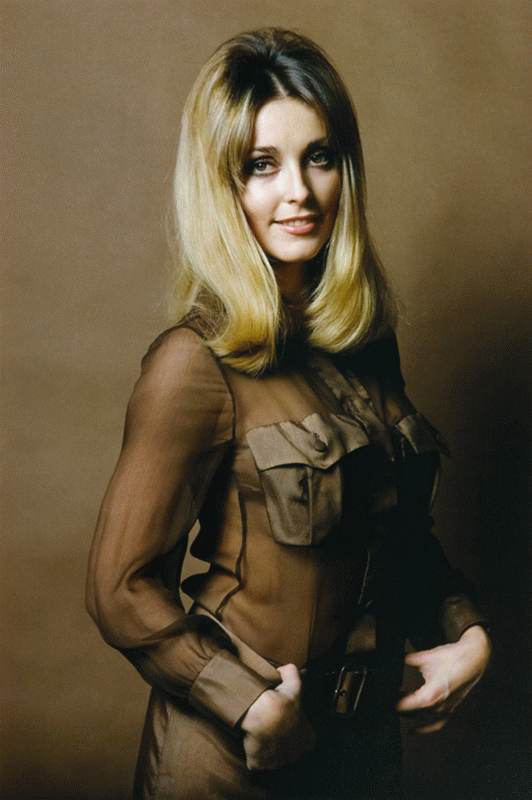In a single photograph taken by Life magazine’s Bill Ray in London, 1968, Sharon Tate is immortalized not just as a rising Hollywood actress, but as a cultural icon. With her radiant smile, effortlessly chic style, and unmistakable charisma, Tate stands as a symbol of the late 1960s — an era defined by transformation, creativity, and a new kind of feminine freedom.
This image, as timeless as it is evocative, does more than capture a beautiful young woman; it captures a moment — a feeling — in history. A moment when Hollywood glamour met Swinging London, when fashion and film were colliding with social change, and when Sharon Tate appeared to embody all the promise and excitement of youth on the verge of stardom.

The Rise of a Star
Born in Dallas, Texas, in 1943, Sharon Marie Tate moved frequently throughout her childhood due to her father’s military career. It wasn’t until the early 1960s that she began pursuing acting and modeling in earnest, gradually finding her footing in Hollywood. With her luminous looks and soft-spoken charm, Tate quickly caught the attention of directors and audiences alike.
By the mid-1960s, her star was on the rise. She earned roles in films such as Eye of the Devil (1966) and The Fearless Vampire Killers (1967), where she met her future husband, director Roman Polanski. But it was her breakout role as Jennifer North in Valley of the Dolls (1967) that solidified her place as one of Hollywood’s most promising new talents. The performance showcased both her vulnerability and screen presence, earning her critical attention and a Golden Globe nomination.
Sharon wasn’t just a beautiful face — she was a talented actress navigating an industry still unsure of how to treat women as more than decorative figures. Her performances hinted at greater depth to come, and her growing confidence as a performer suggested she was just getting started.

Capturing the Moment: London, 1968
It was during this period of ascent that Bill Ray photographed Sharon in London. The city was pulsing with energy, fashion, and experimentation — a fitting backdrop for a woman whose image was about to become iconic. Dressed with effortless flair and framed by the soft haze of natural light, Tate appeared perfectly at home in this modern, liberated setting.
In Ray’s lens, Sharon is not posed or overly stylized. She simply is. And that’s what makes the image so powerful. Her expression is open and full of life. Her smile — warm and unforced — reflects a woman on the brink of something extraordinary. There’s a sense of both confidence and ease in her demeanor, a knowing look that says: “I’m just getting started.”
This wasn’t just the face of a rising movie star — it was the face of a generation. Sharon represented the shift in beauty ideals and gender roles taking place in the late 1960s. She wasn’t the cold, distant glamour of old Hollywood; she was modern, natural, and undeniably magnetic. Her presence was soft but strong, graceful but grounded — the perfect reflection of a world in transition.

A Life Cut Short, A Legacy That Endures
Tragically, Sharon Tate’s promising career — and her life — came to a shocking end on August 9, 1969, when she was murdered in her Los Angeles home by followers of Charles Manson. She was 26 years old and eight-and-a-half months pregnant with her first child.
The horror of her death stunned the nation and marked a dark turning point in the cultural mood of the 1960s. What had been a decade of youthful optimism and rebellion suddenly gave way to fear, disillusionment, and tragedy. In many ways, Sharon’s death came to symbolize the abrupt end of an era.
And yet, her life should not be remembered solely for how it ended. Sharon Tate was, and remains, a symbol of joy, beauty, talent, and untapped potential. She brought light to the screen and left an impression on everyone who knew her or watched her work. Over the years, her legacy has been lovingly preserved by family members, fans, and film historians who continue to celebrate her life and achievements.

The Power of an Image
Bill Ray’s photograph of Sharon Tate in London stands as one of the most enduring images of the 1960s. It reminds us not only of a singular talent lost too soon, but of a moment in time when hope, style, and artistry seemed to converge in one person.
It’s a portrait of possibility — of what was, what might have been, and what still resonates.
Sharon Tate remains a lasting icon not just because of her beauty or the tragic circumstances of her death, but because of the joy, energy, and authenticity she radiated in life. That spirit lives on in her films, in photographs like Ray’s, and in the cultural memory of a generation she helped define.

In that single frame, Sharon Tate is not frozen in time — she is forever alive.